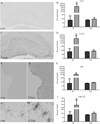Microglial activation is not equivalent to neuroinflammation in alcohol-induced neurodegeneration: The importance of microglia phenotype
- PMID: 23313316
- PMCID: PMC3629000
- DOI: 10.1016/j.nbd.2012.12.016
Microglial activation is not equivalent to neuroinflammation in alcohol-induced neurodegeneration: The importance of microglia phenotype
Abstract
Excessive alcohol intake, a defining characteristic of an alcohol use disorder (AUD), results in neurodegeneration in the hippocampus and entorhinal cortex that has been linked to a variety of cognitive deficits. Neuroinflammation is thought to be a factor in alcohol-induced neurodegeneration, and microglia activation is a key but not sole component of an inflammatory response. These experiments investigate the effects of ethanol exposure in a well-accepted model of an AUD on both microglial activation and blood brain barrier disruption (BBB) in order to understand their relationship to classical definitions of inflammation and alcohol-induced neurodegeneration. Following a four-day binge ethanol paradigm, rat hippocampal and entorhinal cortex tissue was examined using three distinct approaches to determine microglia phenotype and BBB disruption: immunohistochemistry, autoradiography, and ELISA. After ethanol exposure, there was an increase in [(3)H]-PK-11195 binding and OX-42 immunoreactivity indicative of microglial activation; however, microglia were not fully activated since both OX-6 and ED-1 immunoreactive microglia were absent. This data was supported by functional evidence as there was no increase in the proinflammatory cytokines IL-6 or TNF-α, but a 26% increase in the anti-inflammatory cytokine, IL-10, and a 38% increase in the growth factor, TGF-β, seven days after exposure. Furthermore, there was no evidence of a disruption of the BBB. These data suggest that the four-day binge model of an AUD, which produces neurodegeneration in corticolimbic regions, does not elicit classical neuroinflammation but instead produces partially activated microglia. Partial activation of microglia following binge ethanol exposure suggest that microglia in this model have beneficial or homeostatic roles rather than directly contributing to neurodegeneration and are a consequence of alcohol-induced-damage instead of the source of damage.
Copyright © 2013 Elsevier Inc. All rights reserved.
Figures







Similar articles
-
Activated microglia are implicated in cognitive deficits, neuronal death, and successful recovery following intermittent ethanol exposure.Behav Brain Res. 2013 Jan 1;236(1):270-282. doi: 10.1016/j.bbr.2012.08.052. Epub 2012 Sep 5. Behav Brain Res. 2013. PMID: 22985845
-
Role of MCP-1 and CCR2 in ethanol-induced neuroinflammation and neurodegeneration in the developing brain.J Neuroinflammation. 2018 Jul 5;15(1):197. doi: 10.1186/s12974-018-1241-2. J Neuroinflammation. 2018. PMID: 29976212 Free PMC article.
-
Prior Binge Ethanol Exposure Potentiates the Microglial Response in a Model of Alcohol-Induced Neurodegeneration.Brain Sci. 2016 May 26;6(2):16. doi: 10.3390/brainsci6020016. Brain Sci. 2016. PMID: 27240410 Free PMC article.
-
Mechanisms of neurodegeneration and regeneration in alcoholism.Alcohol Alcohol. 2009 Mar-Apr;44(2):115-27. doi: 10.1093/alcalc/agn079. Epub 2008 Oct 21. Alcohol Alcohol. 2009. PMID: 18940959 Free PMC article. Review.
-
Its complicated: The relationship between alcohol and microglia in the search for novel pharmacotherapeutic targets for alcohol use disorders.Prog Mol Biol Transl Sci. 2019;167:179-221. doi: 10.1016/bs.pmbts.2019.06.011. Epub 2019 Jul 29. Prog Mol Biol Transl Sci. 2019. PMID: 31601404 Review.
Cited by
-
Microglia Dystrophy Following Binge-Like Alcohol Exposure in Adolescent and Adult Male Rats.Front Neuroanat. 2020 Aug 13;14:52. doi: 10.3389/fnana.2020.00052. eCollection 2020. Front Neuroanat. 2020. PMID: 32903737 Free PMC article.
-
Altered relation between lipopolysaccharide-induced inflammatory response and excitotoxicity in rat organotypic hippocampal slice cultures during ethanol withdrawal.Alcohol Clin Exp Res. 2015 May;39(5):827-35. doi: 10.1111/acer.12705. Epub 2015 Apr 6. Alcohol Clin Exp Res. 2015. PMID: 25845566 Free PMC article.
-
Glial cells as influencers and maladaptive consequences of alcohol use disorders.J Neurosci Res. 2021 Aug;99(8):1905-1907. doi: 10.1002/jnr.24868. Epub 2021 Jun 1. J Neurosci Res. 2021. PMID: 34062005 Free PMC article.
-
Vulnerability of the Hippocampus to Insults: Links to Blood-Brain Barrier Dysfunction.Int J Mol Sci. 2024 Feb 6;25(4):1991. doi: 10.3390/ijms25041991. Int J Mol Sci. 2024. PMID: 38396670 Free PMC article. Review.
-
Alcohol and adult hippocampal neurogenesis: promiscuous drug, wanton effects.Prog Neuropsychopharmacol Biol Psychiatry. 2014 Oct 3;54:103-13. doi: 10.1016/j.pnpbp.2014.05.003. Epub 2014 May 17. Prog Neuropsychopharmacol Biol Psychiatry. 2014. PMID: 24842804 Free PMC article. Review.
References
Publication types
MeSH terms
Substances
Grants and funding
LinkOut - more resources
Full Text Sources
Other Literature Sources
Medical

